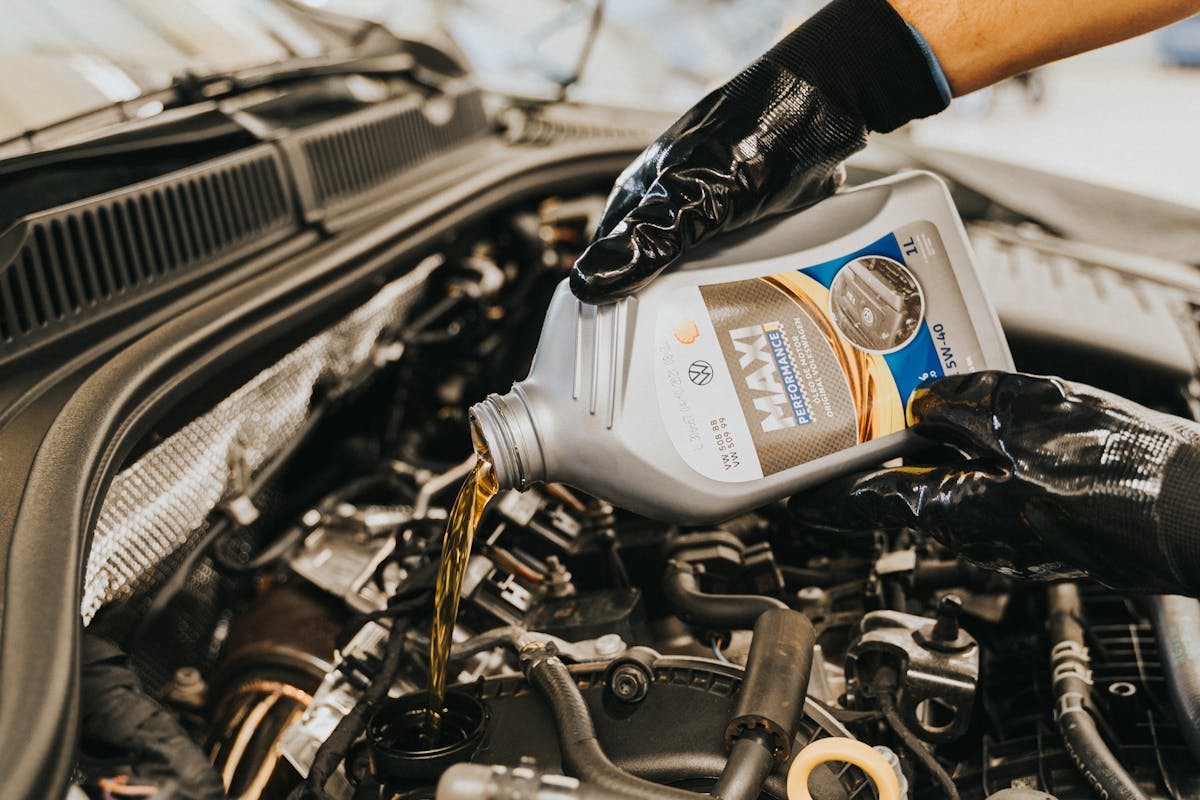How to Choose the Best Engine Oil for Your Car?
The selection of appropriate engine oil for your car is an intricate process that demands a thorough understanding of certain essential factors. These factors encompass manufacturer recommendations, oil viscosity ratings, the distinction between synthetic and conventional oil, and the significance of oil additives. The consequences of this decision directly impact your vehicle’s performance, longevity, and overall health. Consequently, opening up a discourse on this topic is certainly of utmost importance. Are you prepared to navigate this complex yet essential aspect of car maintenance?
Understanding Your Car’s Requirements
To truly comprehend the ideal engine oil for your vehicle, it is essential to understand your car’s specific requirements. A key aspect of this is acknowledging the car manufacturer recommendations, which provide a baseline for your vehicle’s oil requirements. Car manufacturers typically provide specific oil type recommendations based on your vehicle model, engine type, and year. These recommendations take into account the engine’s design, tolerances, combustion chamber, operating temperatures, and emissions control systems. Following these guidelines guarantees peak engine performance and longevity.
In addition to the car manufacturer recommendations, climate considerations are an integral part of selecting the right engine oil. The oil’s viscosity, or thickness, can be affected by temperature changes. In colder climates, thinner oil is preferable as it flows better and can easily start the engine. Conversely, in warmer climates, thicker oil is favored as it does not thin out easily and provides adequate lubrication. As a result, the climate in which the vehicle operates greatly influences the choice of engine oil.
Decoding the Engine Oil Label
Deciphering the information on an engine oil label is essential to selecting the most suitable product for your vehicle. The label provides key data such as the oil’s viscosity rating, which indicates its flow rate at different temperatures, and whether it’s synthetic or conventional, determining its performance and longevity under various conditions. Additionally, it outlines oil standards, ensuring the oil meets specific industry requirements and quality benchmarks.
Understanding Oil Viscosity Ratings
A journey into the depths of an engine oil label can often feel like deciphering an ancient script, but understanding these codes is critical for car maintenance. To fully comprehend what these labels mean, one needs to understand oil viscosity ratings.
- Viscosity: This refers to the oil’s resistance to flow. A higher viscosity means the oil is thicker and flows slower. It’s measured at a specific oil temperature, normally at 100 degrees Celsius.
- Viscosity Range: This is denoted by two numbers, such as 10W-30. The first number (10W) indicates the viscosity at low temperatures (W stands for Winter), and the second number (30) denotes the viscosity at 100 degrees Celsius.
- Oil Temperature: The viscosity of oil changes with temperature. At colder temperatures, oil is thicker, and at warmer temperatures, it’s thinner. The oil needs to have an appropriate viscosity at the engine’s operating temperature to guarantee a smooth operation.
- Viscosity Index (VI): This denotes how much the viscosity of oil changes with temperature. A higher VI means the oil’s viscosity changes less with temperature variations, which is desirable.
Understanding these elements of an engine oil label is a step towards guaranteeing your car’s engine runs efficiently and lasts longer.
Synthetic Versus Conventional Oil
While many motorists might overlook the difference, the choice between synthetic and conventional oil can greatly impact the longevity and performance of your engine. Synthetic oil, created through a complex chemical process, offers advantages that conventional oil, a direct derivative of crude oil, cannot match.
Synthetic benefits include superior lubrication, leading to less wear and tear on engine parts and extended engine life. It has a lower viscosity index, meaning it flows more easily at cold temperatures, providing rapid engine protection after ignition. It’s also more resistant to thermal breakdown, a common cause of engine sludge. Additionally, synthetic oil generally requires less frequent changes, potentially reducing maintenance costs over time.
Conversely, conventional oil has its drawbacks. It’s more likely to evaporate at high temperatures, leading to oil thickening, decreased fuel efficiency, and increased emissions. It also contains more impurities which can contribute to deposit formation, ultimately damaging your engine. However, conventional oil is often less expensive upfront, but continued use may lead to higher costs in the long run due to potential engine issues and more frequent oil changes.
Importance of Oil Standards
Understanding the labels on engine oil containers is another key aspect of choosing the best oil for your car. These labels often contain a wealth of information about the oil certification benefits and industry standardization, both of which are critical in determining the oil’s compatibility and performance with your vehicle.
- Oil Certification Benefits: The oil certification symbol on the label indicates that the oil meets specific performance and quality standards set by the industry. These certifications are a guarantee that your engine oil has passed rigorous testing and can provide maximum protection for your engine.
- Industry Standardization: The standardization of engine oils within the industry guarantees uniformity in the quality and performance of oils. This standardization simplifies the selection process for consumers and assures them of the oil’s reliability.
- Viscosity Grade: The viscosity grade on the label indicates the oil’s resistance to flow. A lower number indicates a thinner, lighter oil that flows easily at low temperatures, while a higher number signifies a thicker oil suitable for high-temperature operation.
- Oil Type: The type of oil (conventional, synthetic, or blend) is also indicated on the label, giving you a clear idea about the oil’s formulation and intended application.
Understanding these oil standards can greatly improve your ability to select the most suitable engine oil for your car.
Synthetic Vs Conventional Oil
Although it may seem like a minor decision, choosing between synthetic and conventional oil for your vehicle is a crucial aspect of routine maintenance. Synthetic oil, engineered from chemically modified petroleum compounds, typically exhibits superior high-temperature stability and lower volatility, thereby providing enhanced engine protection and extending oil longevity.
In contrast, conventional oil, derived directly from crude oil, has a broader range of molecule sizes. This means that it can evaporate more readily under high temperatures, accelerating engine wear and reducing oil longevity. However, advancements in refining processes have greatly improved the quality of conventional oil, narrowing the performance gap between the two types.
When considering environmental impact, synthetic oil takes the lead. Its high-temperature stability and resistance to oxidation reduce harmful emissions. Additionally, the extended drain intervals of synthetic oil mean less oil waste and less frequent oil changes, contributing to its environmental advantage.
Ultimately, the choice between synthetic and conventional oil should be based on the vehicle’s make and model, driving conditions, and manufacturer recommendations. An informed decision can guarantee peak vehicle performance, extend engine life, and reduce environmental impact.

Importance of Oil Viscosity
The concept of oil viscosity plays a pivotal role in the performance and longevity of a vehicle’s engine. It fundamentally influences the lubrication quality, heat management, and overall efficiency of the engine operation. Consequently, selecting the appropriate viscosity grade, aligned with the manufacturer’s recommendations and the driving conditions, is a critical aspect of engine maintenance.
Understanding Oil Viscosity
In the domain of automotive maintenance, the concept of oil viscosity stands as an essential element. Viscosity, in simple terms, refers to the thickness or thinness of the oil. It is a measure of the oil’s resistance to flow and shear, and it is directly influenced by the oil temperature.
To comprehend the importance of oil viscosity, consider the following points:
- Cold Start Capability: The viscosity of oil changes with temperature. At low oil temperatures, a high-viscosity oil may become too thick to circulate efficiently, leading to inadequate engine lubrication.
- High-Temperature Stability: As oil temperature increases, low-viscosity oils may become too thin to provide sufficient lubrication. Hence, a balance between high and low-temperature viscosities is vital.
- Viscosity Effects on Lubrication: The viscosity effects on the oil’s capacity to reduce friction and wear in the engine are significant. Inadequate viscosity may lead to metal-on-metal contact.
- Fuel Efficiency: The viscosity of engine oil can also affect fuel efficiency. Thicker oils require more energy to pump, which can result in higher fuel consumption.
Understanding these aspects is vital when choosing engine oil, as it impacts the longevity and performance of your vehicle.
Viscosity’s Impact on Performance
Remarkably, the viscosity of engine oil plays a pivotal role in determining vehicle performance. Viscosity is the oil’s resistance to flow and shear within the engine’s mechanical systems. This intrinsic property affects how effectively an engine runs, particularly at varying temperature extremes.
The viscosity effects become evident during engine startup, especially under cold conditions. Low-viscosity oil flows smoothly, circumventing sluggish engine performance by providing prompt lubrication to critical engine parts. Conversely, high-viscosity oil moves slower, which can result in insufficient lubrication and undue engine wear.
Temperature considerations also have significant implications for oil viscosity. At high temperatures, thin oils may lose viscosity, leading to reduced lubrication and possible engine damage. On the other hand, thick oils can maintain their viscosity, providing adequate lubrication at high temperatures.
However, the high viscosity can hamper performance at low temperatures, as the oil becomes too thick to circulate efficiently. Therefore, the viscosity of the oil should be suitable for the operating temperature conditions that the vehicle will typically encounter.
In essence, the impact of viscosity on engine performance is a delicate balance that hinges upon the oil’s ability to flow at diverse temperatures and protect the engine under different operating conditions.
Choosing the Right Viscosity
Maneuvering through the myriad options of engine oil viscosities can seem intimidating, yet it is vital for enhancing engine performance and longevity. Temperature effects and driving conditions play significant roles in determining the correct viscosity for your vehicle’s engine oil.
- Temperature Effects: Viscosity varies inversely with temperature. In colder climates, lower viscosity oil provides better start-up lubrication. Conversely, high temperatures require higher viscosity oils to resist thinning.
- Driving Conditions: Stop-and-go city driving or long-distance highway driving can impact your choice of oil viscosity. The former often necessitates lower viscosity oils due to frequent engine startups and short runs, while the latter typically requires higher viscosity oil for continuous high-temperature operation.
- Engine Age and Condition: Older or high-mileage engines may benefit from higher viscosity oils that provide better sealing and cushioning between worn parts.
- Manufacturer’s Recommendations: Always consider the manufacturer’s advice. They have tested the engine’s performance with various oil viscosities under a range of conditions.
Choosing the right viscosity, while considering temperature effects and driving conditions, is essential to maintain the engine’s health and guarantee peak performance. A nuanced understanding of these factors can lead to an informed choice of engine oil.
Considering Oil Additives
Have you ever pondered the role of oil additives in your car’s engine performance? Oil additives are essential components that enhance oil performance and offer a variety of additive benefits. These sophisticated chemical compounds are specifically engineered to augment the inherent properties of base oils, improving their ability to protect and lubricate your engine.
Primarily, there are three categories of oil additives: performance enhancers, protective agents, and problem solvers. Performance enhancers, such as viscosity index improvers and friction modifiers, boost the oil’s effectiveness under extreme conditions. Protective agents, including antioxidants, detergents, and dispersants, shield the engine from damage by combating harmful substances and maintaining oil purity. Problem solvers, like seal conditioners and foam inhibitors, rectify specific engine issues that could otherwise degrade oil performance.
However, an excess of additives can be detrimental. They can upset the delicate balance of your engine oil, triggering problems instead of solving them. As a result, it’s vital to choose an oil with a well-balanced additive package that aligns with your engine’s specific needs. Remember, the best engine oil is not necessarily the one with the most additives, but the one that offers ideal performance for your particular vehicle.
Role of Oil in Engine Performance
After understanding the importance of oil additives in enhancing engine oil performance, we now turn our attention to the overarching role of oil in engine performance. The engine oil primarily performs four key functions:
- Engine Lubrication: It minimizes friction between moving parts, reducing wear and tear and ensuring smooth operation.
- Heat Dissipation: It absorbs and disperses heat generated by engine components, helping to prevent overheating.
- Dirt and Contaminant Suspension: It suspends microscopic particles and contaminants, preventing them from settling and causing damage.
- Sealing: It aids in sealing the gap between piston rings and cylinder walls, enhancing engine efficiency.
The efficiency of these functions is directly tied to the oil’s viscosity and its ability to resist breakdown. Oil breakdown can be disastrous, leading to inadequate engine lubrication, excessive heat, and an accumulation of dirt. As a result, the oil’s ability to maintain its viscosity and resist breakdown under extreme conditions is vital. Hence, the right choice of engine oil can greatly enhance engine performance, longevity, and overall vehicle health, making it a key aspect of vehicle maintenance.
Price and Brand Considerations
Steering through the domain of engine oils, price and brand inevitably become important factors. The cost of engine oil can vary greatly, depending on the brand and the specific product’s features. Hence, conducting a thorough price comparison is essential to guarantee you’re getting the best deal without compromising on quality.
Brand reputation, on the other hand, is a vital determinant of the oil’s reliability and performance. Established brands often have a proven track record of delivering high-quality products, backed by continuous research and development. These brands make certain that their engine oils meet the latest industry standards and vehicle manufacturers’ specifications.
However, the brand’s reputation and price shouldn’t be the sole deciding factors. It’s necessary to take into account the engine oil’s specific characteristics such as viscosity grade, additives, and whether it’s mineral, synthetic, or semi-synthetic.
Regular Oil Change: A Must
A essential aspect of vehicle maintenance, undeniably, is the regular changing of engine oil. It’s a non-negotiable process that guarantees the longevity of your car’s engine, playing an important role in maintaining engine cleanliness and performance.
The oil change frequency depends on several factors, including the type of oil used, the age of your vehicle, your driving habits, and the environmental conditions. To illustrate this, let’s consider the following:
- Full synthetic oil can last up to 15,000 miles, or one year, before needing a change.
- Synthetic blend oil, a mix of conventional and synthetic oil, requires changing every 5,000 to 7,500 miles.
- Conventional oil, commonly used in older vehicles, requires more frequent changes — every 3,000 to 5,000 miles.
- High-mileage oil, designed for vehicles with over 75,000 miles, can go between 5,000 and 7,500 miles.
In essence, a regular oil change is indispensable for maintaining your engine’s health and efficiency. It minimizes the decrease of friction-induced wear, maintains engine cleanliness, and promotes the smooth running of your vehicle.
Frequently Asked Questions
How Does the Weather Affect My Choice of Engine Oil?
Weather impacts your engine oil choice through temperature effects. In colder climates, lower viscosity oil is preferred for easier engine start-up while higher viscosity oil is ideal for hotter climates to guarantee consistent lubrication.
Can I Mix Different Brands of Engine Oil?
Mixing different brands of engine oil is not advisable due to potential incompatibility issues. Brand performance can vary and combining them may compromise the protective, lubricating qualities essential for peak engine function. Always consult your car’s manual or a professional.
What Is the Significance of the API Service Symbol on the Oil Container?
The API service symbol on the oil container signifies the oil’s quality and performance standards. It guarantees the oil meets specific API standards, providing reliable information about the oil’s suitability for various engine types.
Can I Switch From Synthetic Oil to Conventional Oil or Vice Versa?
Yes, you can switch between synthetic and conventional oil. However, consider oil type compatibility and potential engine performance impact. Always consult your vehicle’s manual or a professional before making such changes to guarantee peak performance.
What Does ‘High Mileage’ Oil Mean and When Should It Be Used?
‘High mileage’ oil is specifically designed for vehicles with over 75,000 miles. It provides special benefits like reducing oil consumption and leakage. It should be used when the manufacturer recommends and according to oil change frequency.






